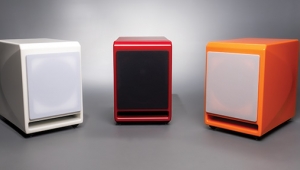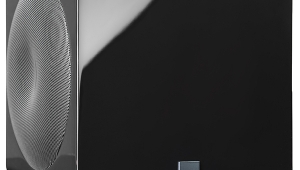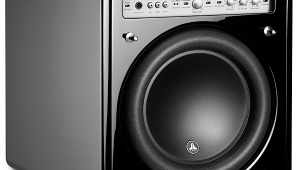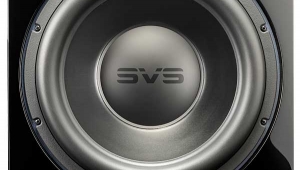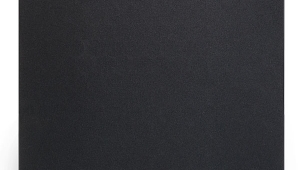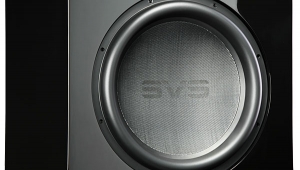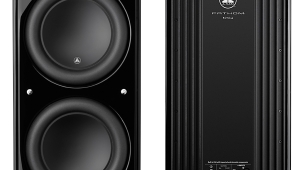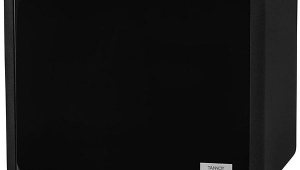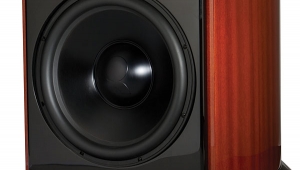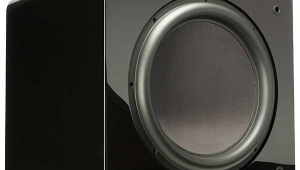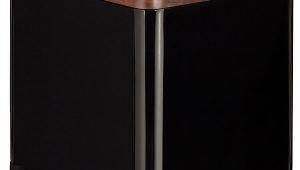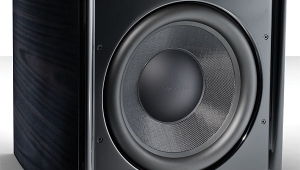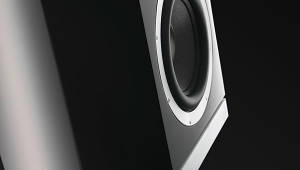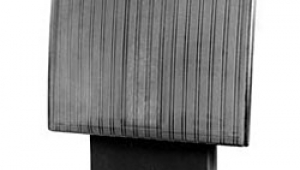| Columns Retired Columns & Blogs |
Nelson-Reed 1204 subwoofer
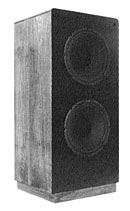 I was so impressed by the Nelson-Reed 8-04/B loudspeaker's low-end range that I seriously doubted the add-on subwoofers could add enough of significance to be cost-effective.
I was so impressed by the Nelson-Reed 8-04/B loudspeaker's low-end range that I seriously doubted the add-on subwoofers could add enough of significance to be cost-effective.
I was wrong.
Two of the subwoofers were provided, along with the necessary electronic crossover unit. Each 1204 unit contains four 12" woofers in a very solid sealed enclosure, with two facing to the front and two facing the rear. The electronic crossover has three controls, besides the AC power switch: a hardwire (footnote 1) bypass switch, a stereo/mono switch, and a subwoofer level control. In the stereo mode, the low frequencies are kept separate, left from right; in mono mode, they are blended together for feeding to a single subwoofer. I will not resurrect the question of whether or not it is important to maintain stereo separation into the LF range, except to echo N-R's observation that there is no LF separation on analog discs to begin with; the lows are mixed together, to limit vertical excursions of the cutting stylus that could cause it to rise above the disc surface or, worse, dig into the aluminum base of the master disc.
There is, however, LF separation on all other signal sources, and I can vouch for the fact that, when the blend switch was set to Mono, there was a slight loss of LF detail. There was not, however, any effect on the stereo soundstage that I could hear. The point here, though, is that the 1204's crossover allows the option of blending low end so that a single woofer may be used if desired, or until you can afford to buy a second one.
Set-up
Anyone who has ever tried using subwoofers knows that they are fiendishly difficult to place optimally in a listening room of average size, because the lower the frequencies you put into a room, the more trouble you are likely to have with standing waves. It took me about 10 hours of sweating and cursing (they're heavy and bulky) to get the 1204s in satisfactory locations, and I've had more experience doing this sort of thing than most audiophiles.
About the only advice I can give is that you start with them right next to and beyond the outer edges of the upper-range speakers, check either pair for phasing (unless you're certain neither of your power amps inverts phase), and rephase them if necessary. Then use a continuously variable oscillator to sweep through the low-end range, starting from about an octave above the crossover point, and listen for peaks and dips. There will be lots of both. Then start moving the woofers toward the rear room corners, symmetrically. What you're looking for is a combination of maximum smoothness and strongest output through the 20–25Hz range. Don't try for best LF/upper-range balance; you can always correct that with the crossover's balance control.
Two cautions: You don't want to end up with a deep dip at around 40Hz; that's the frequency of a bass drum and the bottom of a double bass's range. And avoid any speaker location that gives a sharp 60Hz peak; this will exaggerate hum from any available source. (If you live in Europe, it's 50Hz you have to worry about.) Practically any amplifier of adequate power (50W and more) will suffice to drive subwoofers, but solid-state amplifiers do better than tubes, and more power and/or more current capability will improve LF detail and control. I used an Octave Research, and also tried the Threshold SA-1s (while I had the Audio Research M300s on top), and it was a toss-up.
Sound Quality
The 1204 subwoofer is claimed to be flat (to within 3dB) down to an astonishingly deep 16Hz. There is practically no musical material available with that kind of bottom on it; only a few very large pipe organs can produce a 16Hz tone, which (in fact) is too deep to be heard anyway, but is felt as a pressure on the body. (In fact, I could not verify N-R's 16Hz claim. In my 19'x24' room, the best I could do was get the system fairly flat down to 20Hz, which is still astonishingly deep when you actually hear it.) Even then, the only material with deep enough low end to show off the 1204's low end really spectacularly was nonmusical stuff like trains, of which I just happened to have two CDs on hand: the two "Sounds of Trains" discs from Bainbridge Record (see feature record review in this issue).
Because trains are very big and heavy, they produce sounds which range well down into the subsonic. The "real" sound of heavily loaded steel wheels crossing a track join literally shakes the earth, and there are many examples of that sound on these two discs. The effect was truly awesome! My listening room has a concrete floor, and I know the system doesn't have the power to set that floor into vibration, but with the 1204s in action, it certainly felt as if the floor was shaking. They produced what was without a doubt the deepest low end I have ever heard in my listening room. And the quality of that bass was outstanding, too. While it never had that powerful throb you hear from a live pipe organ or double bass, it was very well controlled and had excellent pitch delineation. As a matter of fact, the 1204 subwoofers meshed very well with the the Sound Lab A-3 speakers, too, using the same crossover. I believe they (or one of them, anyway) would be ideal for use with Quads, but didn't get a chance to try that combination. (DO has a pair of the ESL-63s; perhaps he can be persuaded to try this combination.)
But just because powerful subbass is rare from music recordings doesn't mean that extended bottom is wasted on them. Far from it! It makes a substantial difference with large-scale musical material, even though none of the actual notes go below 40Hz, because it gives a much-enhanced sense of the hall surrounding the musicians. All very large enclosed performing spaces have a continuous background of infrasonic rumble, which is rarely missed when it's not reproduced, but does wonders for realism when it is. But the addition of that low-end extension is not always an unmixed blessing. There is low-frequency stuff on some recordings which man was never intended to hear. For example, Reference Recordings' "Tafelmusic" and the Bruckner symphony excerpt on the HFN/RR test and demo CD have constant underpinnings of random, unidentifiable thuds and rumbles (ruds and thumbles?). For such recordings, you can always switch the crossover to Bypass.
Other than proper room placement, the most important thing about any subwoofer system is that it be operated at a judicious level. There is always the temptation to set it too high, apparently due to the feeling that there's no point paying all that money for it if you can't hear it most of the time. But not only will excessive level sound wrong, it will also tend to muddy up the low end. Generally, the less deep bass you have, the tighter it will sound. (This is at least partly because real-life bass tends to die out rather slowly, and if that slow decay remains audible for too long, because of exaggerated level, it will sound like hangover.)
The only problem I found with the 1204s was in the crossover, which adds a subtle veil to the sound. The high end passes through active circuitry, and designing active circuitry that has no effect at all on the sound is still a supreme challenge even for preamp and power amp designers. But not to worry; N-R has a fix for that, too. The PC-1204 is a small box containing a passive high-pass crossover, which you can use in place of the active one to solve the problem completely. It has outputs for the upper-range amps and for the active unit. At $25 from N-R, $50 from a dealer, it's worth it, although it would seem to make more sense if N-R included the passive circuit in the main active crossover unit.
Conclusion
The Nelson-Reed 1204s are excellent subwoofers, well worth their price in my opinion. And the combination of one or two of these and the 8-04/Bs yields what I feel to be a near-state-of-the-art, supremely musical system that may be hard to beat, especially at this price. I am impressed.
Footnote 1: Hardwiring means the bypass is direct, and will feed signal through even when the device is turned off.
- Log in or register to post comments
